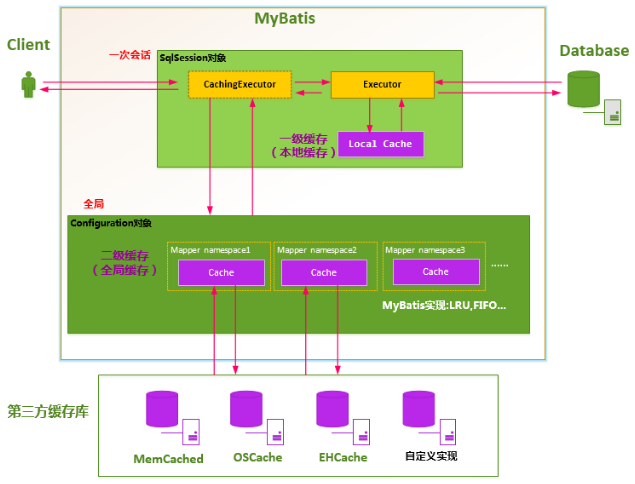Mybatis (六) 一级缓存和二级缓存
一级缓存和二级缓存
本文参考了下文:
一级缓存
Mybatis 对缓存提供了支持,在没有配置的情况下,Mybatis默认只开启一级缓存,一级缓存其实就是依托于SqlSession,即使用同一个SqlSession操作下,如果Sql语句和参数都没有变化,SqlSession第一次会发送SQL,再缓存没有失效的情况下,后面的查询,就会直接去二级缓存中查找,不再像数据库发送SQL查询。
图片来源于上述链接博文:

为什么要使用一级缓存,不用多说也知道个大概。但是还有几个问题我们要注意一下。
1、一级缓存的生命周期有多长?
a、MyBatis在开启一个数据库会话时,会创建一个新的SqlSession对象,SqlSession对象中会有一个新的Executor对象。Executor对象中持有一个新的PerpetualCache对象;当会话结束时,SqlSession对象及其内部的Executor对象还有PerpetualCache对象也一并释放掉。
b、如果SqlSession调用了close()方法,会释放掉一级缓存PerpetualCache对象,一级缓存将不可用。
c、如果SqlSession调用了clearCache(),会清空PerpetualCache对象中的数据,但是该对象仍可使用。
d、SqlSession中执行了任何一个update操作(update()、delete()、insert()) ,都会清空PerpetualCache对象的数据,但是该对象可以继续使用
2、怎么判断某两次查询是完全相同的查询?
mybatis认为,对于两次查询,如果以下条件都完全一样,那么就认为它们是完全相同的两次查询。
2.1 传入的statementId
2.2 查询时要求的结果集中的结果范围
2.3 这次查询所产生的最终要传递给JDBC java.sql.Preparedstatement的Sql语句字符串(boundSql.getSql() )
2.4 传递给java.sql.Statement要设置的参数值
一级缓存验证
我们依托于前面的示例,
Role:
@NoArgsConstructor
@AllArgsConstructor
@Getter
@Setter
@ToString
public class Role{
private Integer id;
private String roleName;
private String description;
private Integer status;
private Date createTime;
private String createUser;
private Date modifyTime;
private String modifyUser;
}
RoleMapper:
public interface RoleMapper {
Role findById(Integer id);
}
下面是测试一级缓存的方法:
public class AppTest {
SqlSession sqlSession = null;
@Before
public void init(){
String resource = "mybatis.configuration.xml";
InputStream inputStream = AppTest.class.getClassLoader().getResourceAsStream(resource);
sqlSession = new SqlSessionFactoryBuilder().build(inputStream).openSession(true);
}
@Test
public void testFindRoleById(){
RoleMapper mapper = sqlSession.getMapper(RoleMapper.class);
Role role1 = mapper.findById(1);
Role role2 = mapper.findById(1);
System.out.println(role1);
System.out.println(role2);
sqlSession.close();
}
}
测试结果:

二级缓存
Mybatis的二级缓存是SqlSessionFactory层面的,一级缓存是SqlSession层面的。

默认情况下,只启用了本地的会话缓存,也就是一级缓存,基于SqlSession的 ,但是如果需要开启二级缓存的话,只需要在Mapper.xml文件中添加一行:
<cache/>
基本上就是这样。这个简单语句的效果如下:
- 映射语句文件中的所有 select 语句的结果将会被缓存。
- 映射语句文件中的所有 insert、update 和 delete 语句会刷新缓存。
- 缓存会使用最近最少使用算法(LRU, Least Recently Used)算法来清除不需要的缓存。
- 缓存不会定时进行刷新(也就是说,没有刷新间隔)。
- 缓存会保存列表或对象(无论查询方法返回哪种)的 1024 个引用。
- 缓存会被视为读/写缓存,这意味着获取到的对象并不是共享的,可以安全地被调用者修改,而不干扰其他调用者或线程所做的潜在修改。
二级缓存验证
RoleMapper.xml:
<?xml version="1.0" encoding="UTF-8" ?>
<!DOCTYPE mapper PUBLIC "-//mybatis.org//DTD Mapper 3.0//EN" "http://mybatis.org/dtd/mybatis-3-mapper.dtd" >
<mapper namespace="com.ooyhao.mybatis4.mapper.RoleMapper">
<!--开启二级缓存-->
<cache />
<resultMap id="base_map_4" type="role">
<id column="id" jdbcType="INTEGER" property="id" />
<result column="role_name" jdbcType="VARCHAR" property="roleName"/>
<result column="description" jdbcType="VARCHAR" property="description"/>
<result column="status" jdbcType="INTEGER" property="status"/>
<result column="create_time" jdbcType="TIMESTAMP" property="createTime"/>
<result column="create_user" jdbcType="VARCHAR" property="createUser"/>
<result column="modify_time" jdbcType="TIMESTAMP" property="modifyTime"/>
<result column="modify_user" jdbcType="VARCHAR" property="modifyUser"/>
</resultMap>
<select id="findById" resultMap="base_map_4">
select * from tb_role where id = #{id}
</select>
</mapper>
如xml文件所述,我们仅在RoleMapper文件下添加<cache/> 用于开启当前namespace 的缓存。
单元测试方法:
(需要注意,我们需要将自动提交关闭,即openSession()的参数设置为false,或不填,否则无法进行缓存)
@Test
public void testFindRoleByIdWithCache(){
//二级缓存是在SqlSessionFactory层面的。
String resource = "mybatis.configuration.xml";
InputStream stream = AppTest.class.getClassLoader().getResourceAsStream(resource);
SqlSessionFactoryBuilder builder = new SqlSessionFactoryBuilder();
//创建SqlSessionFactory
SqlSessionFactory build = builder.build(stream);
SqlSession sqlSession1 = build.openSession();
RoleMapper mapper = sqlSession1.getMapper(RoleMapper.class);
Role role1 = mapper.findById(1);
System.out.println(role1);
RoleMapper mapper1 = sqlSession1.getMapper(RoleMapper.class);
Role role = mapper1.findById(1);
System.out.println(role);
sqlSession1.commit();
SqlSession sqlSession2 = build.openSession();//创建了一个新的session。
RoleMapper roleMapper = sqlSession2.getMapper(RoleMapper.class);
Role role2 = roleMapper.findById(1);
System.out.println(role2);
sqlSession2.commit();
}
此时测试结果为:(报未序列化异常)

所以,我们需要为Role对象加上Serializable接口。
如果我们标注为缓存是只读的话,那么不序列化也不会保错:
<cache readOnly="true" />
测试结果:

这是启用二级缓存之后的执行结果,可以发现查询了3次,但是实际仅仅只发送了一次SQL,我们可以看第二次的Cache Hit Ratio 是0.3333,即三分之一,我们总共查询了三次,在二级缓存中的命中的次数是一次,所以是0.333.
我们像下面这样,增加一次查询:
public class AppTest {
@Test
public void testFindRoleByIdWithCache(){
//二级缓存是在SqlSessionFactory层面的。
String resource = "mybatis.configuration.xml";
InputStream stream = AppTest.class.getClassLoader().getResourceAsStream(resource);
SqlSessionFactoryBuilder builder = new SqlSessionFactoryBuilder();
//创建SqlSessionFactory
SqlSessionFactory build = builder.build(stream);
SqlSession sqlSession1 = build.openSession();
RoleMapper mapper = sqlSession1.getMapper(RoleMapper.class);
Role role1 = mapper.findById(1);
System.out.println(role1);
RoleMapper mapper1 = sqlSession1.getMapper(RoleMapper.class);
Role role = mapper1.findById(1);
System.out.println(role);
sqlSession1.commit();
SqlSession sqlSession2 = build.openSession();
RoleMapper roleMapper = sqlSession2.getMapper(RoleMapper.class);
Role role2 = roleMapper.findById(1);
System.out.println(role2);
sqlSession2.commit();
SqlSession sqlSession3 = build.openSession();
RoleMapper roleMapper3 = sqlSession3.getMapper(RoleMapper.class);
Role role3 = roleMapper3.findById(1);
System.out.println(role3);
sqlSession3.commit();
}
}
执行结果如下:

二级缓存详述
我们知道了如何操作二级缓存,下面我们对二级缓存进行更加详细的了解。
<cache/>
这个简单语句的效果如下:
- 映射语句文件中的所有 select 语句的结果将会被缓存。
- 映射语句文件中的所有 insert、update 和 delete 语句会刷新缓存。
- 缓存会使用最近最少使用算法(LRU, Least Recently Used)算法来清除不需要的缓存。
- 缓存不会定时进行刷新(也就是说,没有刷新间隔)。
- 缓存会保存列表或对象(无论查询方法返回哪种)的 1024 个引用。
- 缓存会被视为读/写缓存,这意味着获取到的对象并不是共享的,可以安全地被调用者修改,而不干扰其他调用者或线程所做的潜在修改。
这些属性可以通过 cache 元素的属性来修改。比如:
<!--开启二级缓存-->
<!--开启本mapper的namespace下的二级缓存-->
<cache eviction="FIFO"
flushInterval="60000"
readOnly="true"
size="512" />
<resultMap id="base_map_4" type="role">
<id column="id" jdbcType="INTEGER" property="id" />
<result column="role_name" jdbcType="VARCHAR" property="roleName"/>
<result column="description" jdbcType="VARCHAR" property="description"/>
<result column="status" jdbcType="INTEGER" property="status"/>
<result column="create_time" jdbcType="TIMESTAMP" property="createTime"/>
<result column="create_user" jdbcType="VARCHAR" property="createUser"/>
<result column="modify_time" jdbcType="TIMESTAMP" property="modifyTime"/>
<result column="modify_user" jdbcType="VARCHAR" property="modifyUser"/>
</resultMap>
<!--可以通过设置useCache来规定这个sql是否开启缓存,ture是开启,false是关闭-->
<select id="findById" resultMap="base_map_4" useCache="true" >
select * from tb_role where id = #{id}
</select>
这个更高级的配置创建了一个FIFO(first in first out) 缓存,每隔60秒刷新,最多可以存储结果对象或列表的512个引用,而且返回的对象被认为是只读的,因此对他们进行修改可能会在不同线程中的调用者产生冲突。
可用的清楚策略有:
- LRU -最近最少使用:移除最长时间不被使用的对象。(默认)
- FIFO -先进先出:按对象进入缓存的顺序来移除它们。
- SOFT - 软引用:基于垃圾回收器状态和软引用规则移除对象。
- WEAK - 弱引用:更积极地基于垃圾收集器状态和弱引用规则移除对象。
flushInterval(刷新间隔)属性可以被设置为任意的正整数,设置的值应该是一个以毫秒为单位的合理时间量。 默认情况是不设置,也就是没有刷新间隔,缓存仅仅会在调用语句时刷新。
size(引用数目)属性可以被设置为任意正整数,要注意欲缓存对象的大小和运行环境中可用的内存资源。默认值是 1024。
readOnly(只读)属性可以被设置为 true 或 false。只读的缓存会给所有调用者返回缓存对象的相同实例。 因此这些对象不能被修改。这就提供了可观的性能提升。而可读写的缓存会(通过序列化)返回缓存对象的拷贝。 速度上会慢一些,但是更安全,因此默认值是 false。
提示: 二级缓存是事务性的。这意味着,当 SqlSession 完成并提交时,或是完成并回滚,但没有执行 flushCache=true 的 insert/delete/update 语句时,缓存会获得更新。
总结:
至此,我们学习了Mybatis的基础知识了,当然,如果我们需要深入理解Mybatis,我们还有很多要学习,所以,学习Mybatis,我们才刚刚开始。后面,我们学习一下如何和Spring整合操作。
源码地址:
https://gitee.com/ooyhao/JavaRepo_Public/tree/master/Mybatis
最后
如果觉得不错的话,那就关注一下小编哦!一起交流,一起学习




 浙公网安备 33010602011771号
浙公网安备 33010602011771号